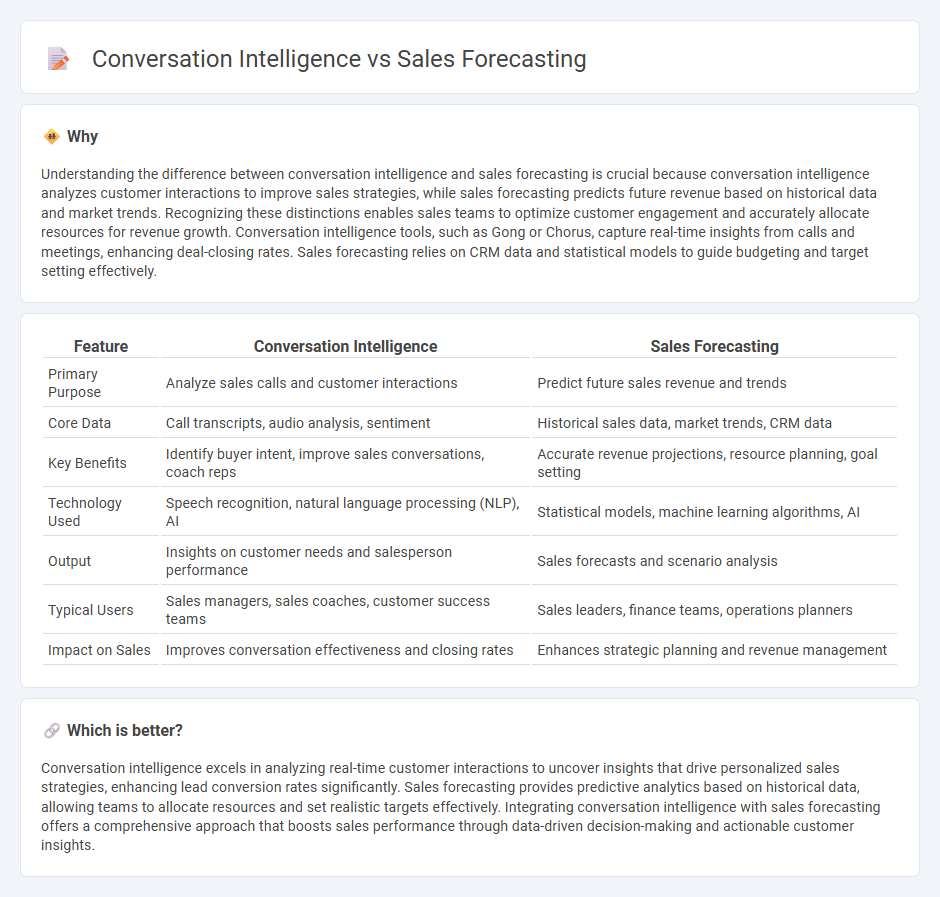
Conversation intelligence analyzes sales calls and interactions to uncover customer insights, identify trends, and improve sales performance through real-time data. Sales forecasting uses historical data and predictive analytics to estimate future revenues and guide strategic planning. Explore how integrating conversation intelligence with sales forecasting can enhance accuracy and drive revenue growth.
Why it is important
Understanding the difference between conversation intelligence and sales forecasting is crucial because conversation intelligence analyzes customer interactions to improve sales strategies, while sales forecasting predicts future revenue based on historical data and market trends. Recognizing these distinctions enables sales teams to optimize customer engagement and accurately allocate resources for revenue growth. Conversation intelligence tools, such as Gong or Chorus, capture real-time insights from calls and meetings, enhancing deal-closing rates. Sales forecasting relies on CRM data and statistical models to guide budgeting and target setting effectively.
Comparison Table
| Feature | Conversation Intelligence | Sales Forecasting |
|---|---|---|
| Primary Purpose | Analyze sales calls and customer interactions | Predict future sales revenue and trends |
| Core Data | Call transcripts, audio analysis, sentiment | Historical sales data, market trends, CRM data |
| Key Benefits | Identify buyer intent, improve sales conversations, coach reps | Accurate revenue projections, resource planning, goal setting |
| Technology Used | Speech recognition, natural language processing (NLP), AI | Statistical models, machine learning algorithms, AI |
| Output | Insights on customer needs and salesperson performance | Sales forecasts and scenario analysis |
| Typical Users | Sales managers, sales coaches, customer success teams | Sales leaders, finance teams, operations planners |
| Impact on Sales | Improves conversation effectiveness and closing rates | Enhances strategic planning and revenue management |
Which is better?
Conversation intelligence excels in analyzing real-time customer interactions to uncover insights that drive personalized sales strategies, enhancing lead conversion rates significantly. Sales forecasting provides predictive analytics based on historical data, allowing teams to allocate resources and set realistic targets effectively. Integrating conversation intelligence with sales forecasting offers a comprehensive approach that boosts sales performance through data-driven decision-making and actionable customer insights.
Connection
Conversation intelligence leverages AI to analyze sales calls, uncovering key insights such as customer needs, objections, and buying signals. These insights feed into sales forecasting models, enhancing accuracy by providing real-time data on deal status and customer sentiment. Integrating conversation intelligence with forecasting allows sales teams to predict revenue more reliably and tailor strategies for higher conversion rates.
Key Terms
Sales Forecasting:
Sales forecasting leverages historical sales data, market trends, and predictive analytics to estimate future revenue and set achievable sales targets. It enables businesses to allocate resources efficiently, optimize inventory levels, and improve overall financial planning. Explore more to understand how accurate sales forecasting drives revenue growth and operational excellence.
Pipeline Analysis
Sales forecasting uses historical sales data and trend analysis to predict future revenue and guide strategic planning. Conversation intelligence captures and analyzes customer interactions to reveal insights into buyer intent and deal progress within the sales pipeline. Explore how integrating these tools enhances pipeline analysis for improved decision-making and revenue growth.
Quota Attainment
Sales forecasting leverages historical data and predictive analytics to estimate future revenue and set realistic quota attainment goals. Conversation intelligence analyzes sales interactions to uncover patterns and insights that directly impact quota achievement by improving sales rep performance and customer engagement. Explore how integrating these tools can optimize quota attainment strategies and drive sales success.
Source and External Links
The Complete Guide to Building Accurate Sales Forecasts - This guide provides a comprehensive overview of sales forecasting, including defining forecast periods, gathering data, selecting forecasting methods, and analyzing trends to project future sales.
What is Sales Forecasting? - This resource explains sales forecasting as a process for estimating future sales using various methods like historical data and market analysis tools to optimize revenue.
Sales Forecasting Methods: A Beginner's Guide - This guide covers the basics of sales forecasting, highlighting its importance across organizational functions and explaining different types of forecasts such as opportunity and retail sales forecasting.
 dowidth.com
dowidth.com